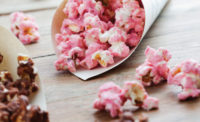State of the Industry: Healthy vs. Indulgent
With “healthier” snacks leading the way, U.S. snack sales increased by 3.2% in 2006, according to Information Resources Inc.’s 2007 State of the Industry report, presented by IRI senior vice president Sally Lyons Watt during SNAXPO. The study showed that “healthier” snack sales increased 6.4% in 2006, far outpacing salty snacks at 3.7%, chocolate at 3.2% and indulgent snacks at 2.1%.
Leading the sales growth in dollars in 2006 versus 2005 were yogurt at 7.9%, snack/granola bars at 5.7%, crackers at 5.4% and frozen novelties at 3.9%. Most sweets categories lagged, with non-chocolate candy at 1.4% growth, ice cream at 0.9%, cookies at 0.7%, and pastry/doughnuts at -2%.
While Wyatt pointed out that the healthier snack category increased three times more than indulgent products, she cautioned snack companies to be careful as they plan their product mix for the future.
”It’s extremely important not to put all of your eggs in the healthy basket, because indulgent snacks still have a 66% share of consumer snack purchases,” said Wyatt, noting that healthy snacks will continue to increase share, but gradually. A huge opportunity, she added, will be healthier versions of indulgent snacks that retain the taste of those products.
According to IRI, healthier versions of indulgent snacks showed exceptional growth last year, with baked cheese puffs up 34.3%, low fat crackers up 24.5%, light ice cream up 14.7%, baked unflavored tortilla chips up 11.9%, sugarless gum up 11.2%, baked potato chips up 8.8%, and light frozen novelties up 7.0%. Baked flavored tortilla chips declined 16.9% and low fat cookies were off 18.5%.
The study showed continued, solid growth in natural/organic snacks, with an 11.7% increase in sales in 2006 and projections of a 9.8% increase in 2007, 8.7% in 2008, 8.1% in 2009 and 7.2% in 2010.
Wyatt said consumers age 55 and older are especially concerned about eating healthier and are important targets for healthy snack products, as are families with young children, given growing concerns about childhood obesity.
“Seventy-eight percent of consumers are trying to eat healthier,” said Wyatt, adding that 66% are trying to eat snacks with nutritional values, 63% are trying to replace high-calorie snacks with healthier options, and 57% are trying to snack less. “Consumers aren’t just trying to lose weight. They are trying to figure out ways to have overall wellness with a focus on the foods they eat.”
The IRI report said that consumers are seeking these health and wellness attributes in snack products:
| No Trans Fats | 57% |
| Low Fat | 47% |
| Whole Grains | 46% |
| Low Cholesterol | 44% |
| Low Sugar | 44% |
| Low Calorie | 43% |
| Low Sodium | 41% |
| Vitamins & Minerals | 39% |
According to the study, 86% of new “product pacesetters” are in snack food categories. Some new product “pacesetters” identified in the study included cold cereal and snack/granola bars, each with 15 new products, crackers with 14, cookies with 13, carbonated beverages with 10, frozen dinners/entrees and bottled juices each with seven, and yogurt with six.
Portion control remains important to consumers, as 100-calorie single-serve packs showed a 47% increase in dollar sales last year. In addition, functional snacks — which provide health benefits beyond basic nutrition — were identified by IRI as a $60 billion market with a 67% increase in sales expected by 2009. Examples of those products are Activia from Dannon for probiotics and Hershey’s dark chocolate for antioxidants.
Wyatt urged manufacturers to look for ways to partner with retailers who are emphasizing health and wellness in their stores. There are significant opportunities in the areas of new product development and targeted marketing and merchandising, she said, adding that the keys to new products are health and wellness, taste and variety, and products that can be seen as meal replacements.
While consumers might see “light” or low-calorie products as ways to improve their diets, the study showed that many people consume light products more frequently than regular. “If we get new consumers coming into the category and they consume it more often, it’s a way to keep the snacking segment very strong,” Wyatt said.
Key Consumer Snack Needs
Although health concerns are influencing snack sales, the IRI report showed that consumers still are making room for indulgence, with 49% of 18-34 year-olds stating that high-calorie snacks can be part of a healthy diet. The same view was held by 46% of 35-44 year olds, 40% of 45-54 year olds and 33% of consumers ages 55 and older. Moreover, 63% said they are more likely to eat what tastes good versus what is good for them.
Eating on-the-go also is a key driver of snack sales and new product development, Wyatt said. The IRI presentation showed that 20% of consumers eat breakfast on-the-go three or more times a week. About 21% do the same with lunch and 9% do the same with dinner. In addition, 47% look for snacks that can be eaten in the car or on-the-go, and 52% want snacks that are not messy.
Percent of Consumers Who Consider Attribute Important in Snack Selection
| 55+ | Under 55 | |
| Low-Cholesterol | 58% | 38% |
| Fresh/Not Processed | 57% | 43% |
| Low-Sugar | 54% | 39% |
| Low-Sodium | 54% | 34% |
| Low-Fat | 54% | 43% |
| Low-Calorie | 52% | 39% |
Manufacturers have an opportunity to make parents’ jobs easier when it comes to helping to improve their children’s’ diets, Wyatt suggested, noting that 63% of parents watch portion sizes, 60% look for snacks with nutrients, 40% offer low-fat snacks and 34% offer low-calorie snacks.
Meanwhile, kids’ flavor preferences in snacks favor sweet and cheesy.
| Under age 6 | Ages 6-11 | Ages 12-17 | |
| Sweet | 61% | 50% | 50% |
| Spicy | 3% | 10% | 21% |
| Cheesy | 29% | 30% | 23% |
Merchandising
The IRI presentation pointed out that the number of store displays are dramatically declining as supermarkets attempt to offer an improved and easier shopping experience for consumers, with more open aisles and less clutter. However, the study suggested that co-merchandising displays and displays designed to “interrupt” the shopper’s trip around the store still are key.
It said that 60% of consumers want to see healthy product indicators on packages, and 58% favor clear store signage to identify healthier products.
The study also said there is an opportunity to build “under-developed” shopping trip types, noting that snacks are purchased in the grocery channel as follows:
| Salty | Total | |||
| Snacks | Cookies | Crackers | CPG | |
| Quick Trip | 22% | 19% | 17% | 53% |
| Fill-in | 22% | 22% | 21% | 15% |
| Pantry Stocking | 46% | 51% | 54% | 14% |
| Special Purpose | 10% | 8% | 8% | 18% |
Partnering On Childhood Obesity
U.S. retailers see childhood obesity as a “real and lasting problem,” and many are looking to food manufacturers to partner with them in an effort to help get that “epidemic” under control.
That was the message offered on Sunday, March 25, by food marketing professor Nancy M. Childs of St. Joseph’s University, Philadelphia, during an educational seminar during SNAXPO.
“We are in an obesity environment shift in the industry,” said Childs as she urged snack food manufacturers to work with retailers and respond by providing products with “a little less salt, a little less fat and maybe whole grains.”
Childs said there are many opportunities for snack food suppliers to provide more branded and private label healthier items for children, including portion-control products like 100-calorie packs. Retailers also want help with merchandising and product promotions, she said, as well as sponsors for activity-based events aimed at kids.
“Retailers have really stepped up on the education side,” she said, suggesting that food manufacturers can help. In-store nutrition education is a growing trend, she said. “There are many opportunities to partner with retailers.”
According to Childs, consumers are “looking for ways to help us snack and feel a little bit better about it, with products with less salt, less fat, with whole grain — something to make me feel better about snacking, and help me know when to stop.”





